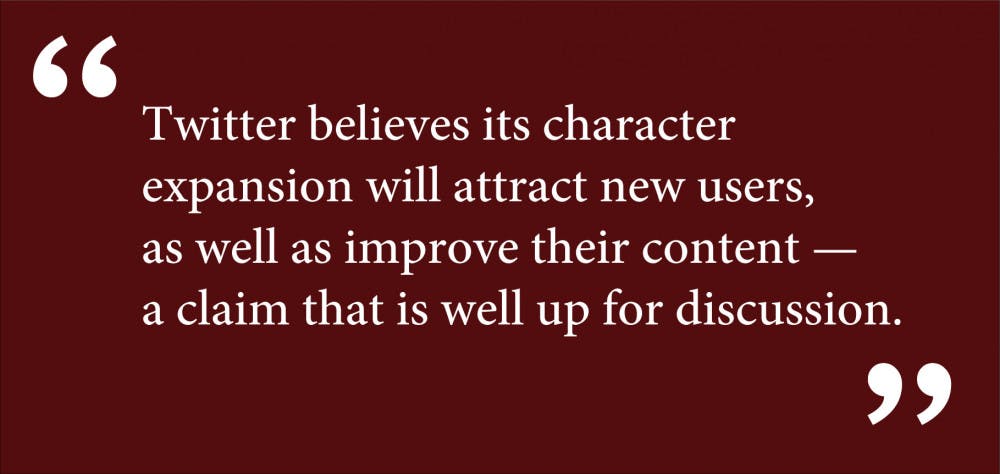On Sept. 26, Twitter announced that the character limit on tweets would be doubled from 140 to 280 characters for a select group of users. This marks the first time since its launch in 2006 that Twitter is changing this standard. Predictably, the shift has sparked a passionate debate within the Twittersphere over the necessity of extra characters. Some, including myself, believe this change is unnecessary and goes against what Twitter has traditionally stood for.
For Twitter purists, this change seems to undermine the very purpose of tweets: to share concise news in a form that is globally accessible. Twitter was created for users to be frugal with their words and stick to essential information. In what has come to define our generation — the generation of social media — people want the most important information as soon as possible.
On the other hand, Twitter has been heavily criticized in recent years for failing to expand their platform and profit. The company has been steadily losing money — at least $2 billion between 2011 and 2016. Twitter is also having trouble attracting new users. From 2011 through 2014, the number of Twitter accounts grew from 68 million to 288 million. In the three years since, Twitter accounts have only increased to 328 million. This deceleration has been scaring investors off for a few years. For a company that almost entirely depends on ad revenue, these statistics are an ominous sign.
Twitter believes its character expansion will attract new users, as well as improve their content — a claim that is well up for discussion.
It is notable that the general public didn’t exactly clamor for this change. People never asked for more characters, although they may have contributed to the change unintentionally. Many users post pictures of longer messages or rant through tweet storms, in which a user replies to their own tweets in a long chain. But again, why does Twitter feel this move is necessary? The change doesn’t seem to have been motivated by any one event, and it could even discourage people from using the platform. The majority of users browse Twitter on their smartphones rather than computers, and a block of text double the size of what they are used to can be intimidating and frustrating to read, forcing users to scroll more. And let’s not forget tweeters like Twitter because of its brevity. The news is quicker, the jokes are simpler and the statements are sweeter — there’s no need for any more space. Twitter should leave the longer posts to Facebook.
If this move expands to all accounts, it will be interesting to see how news outlets, politicians and celebrities take advantage of the extra character space — especially political leaders such as President Trump, who is not a part of the initial beta group. As president, Trump’s use of Twitter has raised the issue of how professional and presidential the platform is and should be. On Twitter, he routinely announces policy changes before official statements and, most recently, disparaged the NFL players who have kneeled during the national anthem. Who knows what someone like Trump could say with all the extra space? How many more “covfefes” will he fail to proofread?
Likewise, news outlets will need to decide whether they want to keep their updates brief or risk losing the short attention span of users. As a user who follows many news organizations, I have a feeling they will begin to include more than necessary. Twitter headlines are supposed to be punchy and act as clickbait, reaching as many users as possible, so the shift could have implications for the accessibility of news and information in a time when news credibility and dissemination are critical.
Still, this isn’t the end of Twitter as we know it. Twitter co-founder and CEO Jack Dorsey admitted the 140 character limit was completely arbitrary. In a tweet announcing the test, Dorsey wrote, “This is a small change, but a big move for us. 140 was an arbitrary choice based on the 160 character SMS limit. Proud of how thoughtful the team has been in solving a real problem people have when trying to tweet. And at the same time maintain our brevity, speed and essence!” It’s clear that Dorsey believes this move won’t affect the way users consume their information. Funnily enough, one intrepid user edited Dorsey’s tweet down to 139 characters, proving that bigger isn’t always better.
It may seem like a big deal now, but every company makes controversial decisions. The public is always quick to adapt, and this is likely no different. Facebook continually updates their layout and adds emoji reactions. Do we still talk about them after a week? A month? Once Twitter goes universal with this change, which I suspect it will, expect the hype and drama surrounding it to die quickly. It’s not a change anyone asked for, but it will become the standard.
That doesn’t mean we shouldn’t mourn the end of the 140-character limit. I love that tweeters are meant to be careful and intentional with their words. Some brevity and precision will be lost in tweets, but hopefully, Twitter sees a productive vision for this change. In the meantime, we should enjoy all the new jokes tweeters are making about all these new characters. As one user put it, “Twitter is suffering what most shows do in their later seasons by introducing a bunch of characters no one really cares about.”
Zander Kim ’19 is not a part of Twitter’s initial beta group and can be reached at alexander_kim@brown.edu. Please send responses to this opinion to letters@browndailyherald.com and other op-eds to opinions@browndailyherald.com





